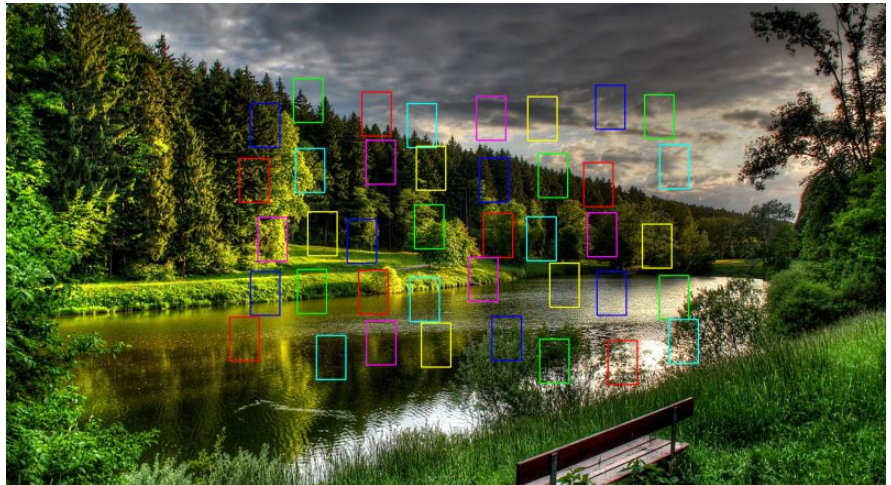这篇文章主要介绍“Python如何实现随机从图像中获取多个patch”,在日常操作中,相信很多人在Python如何实现随机从图像中获取多个patch问题上存在疑惑,小编查阅了各式资料,整理出简单好用的操作方法,希望对大家解答”Python如何实现随机从图像中获取多个patch”的疑惑有所帮助!接下来,请跟着小编一起来学习吧!
经常有一些图像任务需要从一张大图中截取固定大小的patch来进行训练。这里面常常存在下面几个问题:
patch的位置尽可能随机,不然数据丰富性可能不够,容易引起过拟合
如果原图较大,读图带来的IO开销可能会非常大,影响训练速度,所以最好一次能够截取多个patch
我们经常不太希望因为随机性的存在而使得图像中某些区域没有被覆盖到,所以还需要注意patch位置的覆盖程度
基于以上问题,我们可以使用下面的策略从图像中获取位置随机的多个patch:
以固定的stride获取所有patch的左上角坐标
对左上角坐标进行随机扰动
对patch的左上角坐标加上宽和高得到右下角坐标
检查patch的坐标是否超出图像边界,如果超出则将其收进来,收的过程应保证patch尺寸不变
加入ROI(Region Of Interest)功能,也就是说patch不一定非要在整张图中获取,而是可以指定ROI区域
下面是实现代码和例子:
注意下面代码只是获取了patch的bounding box,并没有把patch截取出来。

# -*- coding: utf-8 -*-
import cv2
import numpy as np
def get_random_patch_bboxes(image, bbox_size, stride, jitter, roi_bbox=None):
"""
Generate random patch bounding boxes for a image around ROI region
Parameters
----------
image: image data read by opencv, shape is [H, W, C]
bbox_size: size of patch bbox, one digit or a list/tuple containing two
digits, defined by (width, height)
stride: stride between adjacent bboxes (before jitter), one digit or a
list/tuple containing two digits, defined by (x, y)
jitter: jitter size for evenly distributed bboxes, one digit or a
list/tuple containing two digits, defined by (x, y)
roi_bbox: roi region, defined by [xmin, ymin, xmax, ymax], default is whole
image region
Returns
-------
patch_bboxes: randomly distributed patch bounding boxes, n x 4 numpy array.
Each bounding box is defined by [xmin, ymin, xmax, ymax]
"""
height, width = image.shape[:2]
bbox_size = _process_geometry_param(bbox_size, min_value=1)
stride = _process_geometry_param(stride, min_value=1)
jitter = _process_geometry_param(jitter, min_value=0)
if bbox_size[0] > width or bbox_size[1] > height:
raise ValueError('box_size must be <= image size')
if roi_bbox is None:
roi_bbox = [0, 0, width, height]
# tl is for top-left, br is for bottom-right
tl_x, tl_y = _get_top_left_points(roi_bbox, bbox_size, stride, jitter)
br_x = tl_x + bbox_size[0]
br_y = tl_y + bbox_size[1]
# shrink bottom-right points to avoid exceeding image border
br_x[br_x > width] = width
br_y[br_y > height] = height
# shrink top-left points to avoid exceeding image border
tl_x = br_x - bbox_size[0]
tl_y = br_y - bbox_size[1]
tl_x[tl_x < 0] = 0
tl_y[tl_y < 0] = 0
# compute bottom-right points again
br_x = tl_x + bbox_size[0]
br_y = tl_y + bbox_size[1]
patch_bboxes = np.concatenate((tl_x, tl_y, br_x, br_y), axis=1)
return patch_bboxes
def _process_geometry_param(param, min_value):
"""
Process and check param, which must be one digit or a list/tuple containing
two digits, and its value must be >= min_value
Parameters
----------
param: parameter to be processed
min_value: min value for param
Returns
-------
param: param after processing
"""
if isinstance(param, (int, float)) or \
isinstance(param, np.ndarray) and param.size == 1:
param = int(np.round(param))
param = [param, param]
else:
if len(param) != 2:
raise ValueError('param must be one digit or two digits')
param = [int(np.round(param[0])), int(np.round(param[1]))]
# check data range using min_value
if not (param[0] >= min_value and param[1] >= min_value):
raise ValueError('param must be >= min_value (%d)' % min_value)
return param
def _get_top_left_points(roi_bbox, bbox_size, stride, jitter):
"""
Generate top-left points for bounding boxes
Parameters
----------
roi_bbox: roi region, defined by [xmin, ymin, xmax, ymax]
bbox_size: size of patch bbox, a list/tuple containing two digits, defined
by (width, height)
stride: stride between adjacent bboxes (before jitter), a list/tuple
containing two digits, defined by (x, y)
jitter: jitter size for evenly distributed bboxes, a list/tuple containing
two digits, defined by (x, y)
Returns
-------
tl_x: x coordinates of top-left points, n x 1 numpy array
tl_y: y coordinates of top-left points, n x 1 numpy array
"""
xmin, ymin, xmax, ymax = roi_bbox
roi_width = xmax - xmin
roi_height = ymax - ymin
# get the offset between the first top-left point of patch box and the
# top-left point of roi_bbox
offset_x = np.arange(0, roi_width, stride[0])[-1] + bbox_size[0]
offset_y = np.arange(0, roi_height, stride[1])[-1] + bbox_size[1]
offset_x = (offset_x - roi_width) // 2
offset_y = (offset_y - roi_height) // 2
# get the coordinates of all top-left points
tl_x = np.arange(xmin, xmax, stride[0]) - offset_x
tl_y = np.arange(ymin, ymax, stride[1]) - offset_y
tl_x, tl_y = np.meshgrid(tl_x, tl_y)
tl_x = np.reshape(tl_x, [-1, 1])
tl_y = np.reshape(tl_y, [-1, 1])
# jitter the coordinates of all top-left points
tl_x += np.random.randint(-jitter[0], jitter[0] + 1, size=tl_x.shape)
tl_y += np.random.randint(-jitter[1], jitter[1] + 1, size=tl_y.shape)
return tl_x, tl_y
if __name__ == '__main__':
image = cv2.imread('1.bmp')
patch_bboxes = get_random_patch_bboxes(
image,
bbox_size=[64, 96],
stride=[128, 128],
jitter=[32, 32],
roi_bbox=[500, 200, 1500, 800])
colors = [
(255, 0, 0),
(0, 255, 0),
(0, 0, 255),
(255, 255, 0),
(255, 0, 255),
(0, 255, 255)]
color_idx = 0
for bbox in patch_bboxes:
color_idx = color_idx % 6
pt1 = (bbox[0], bbox[1])
pt2 = (bbox[2], bbox[3])
cv2.rectangle(image, pt1, pt2, color=colors[color_idx], thickness=2)
color_idx += 1
cv2.namedWindow('image', 0)
cv2.imshow('image', image)
cv2.waitKey(0)
cv2.destroyAllWindows()
cv2.imwrite('image.png', image)在实际应用中可以进一步增加一些简单的功能:
1.根据位置增加一些过滤功能。比如说太靠近边缘的给剔除掉,有些算法可能有比较严重的边缘效应,所以此时我们可能不太想要边缘的数据加入训练
2.也可以根据某些简单的算法策略进行过滤。比如在超分辨率这样的任务中,我们可能一般不太关心面积非常大的平坦区域,比如纯色墙面,大片天空等,此时可以使用方差进行过滤
3.设置最多保留数目。有时候原图像的大小可能有很大差异,此时利用上述方法得到的patch数量也就随之有很大的差异,然而为了保持训练数据的均衡性,我们可以设置最多保留数目,为了确保覆盖程度,一般需要在截取之前对patch进行shuffle,或者计算stride
到此,关于“Python如何实现随机从图像中获取多个patch”的学习就结束了,希望能够解决大家的疑惑。理论与实践的搭配能更好的帮助大家学习,快去试试吧!若想继续学习更多相关知识,请继续关注亿速云网站,小编会继续努力为大家带来更多实用的文章!
免责声明:本站发布的内容(图片、视频和文字)以原创、转载和分享为主,文章观点不代表本网站立场,如果涉及侵权请联系站长邮箱:is@yisu.com进行举报,并提供相关证据,一经查实,将立刻删除涉嫌侵权内容。